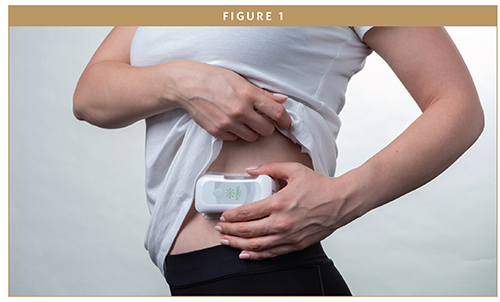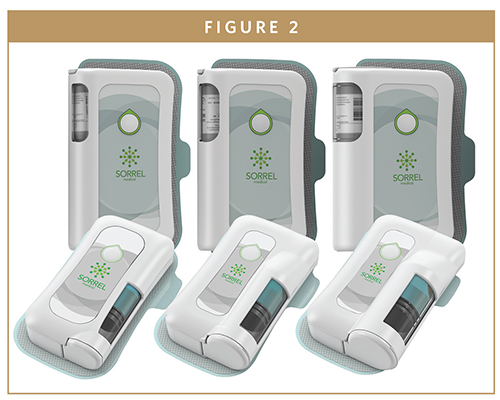Issue:June 2021
WEARABLE PLATFORM - Next-Generation Wearable Drug Delivery: Prefilled Devices Provide a Truly Patient-Centric Solution
A SHIFTING HEALTH LANDSCAPE
Recent technological and biotech developments are changing how we take medications, as well as the types of drugs we take. This has been particularly noticeable with the increasing introduction of new biologic and biosimilar medications, designed to better manage chronic and high-burden diseases. Composed of larger volumes and higher viscosities than small-molecule injectable drugs, these new medications require alternative methods of delivery.
Concurrently, the continued move toward value-based care is placing increasing emphasis on the patient experience, while mounting healthcare costs are encouraging pharmaceutical companies to develop solutions that better address the needs of both patients and healthcare providers. Meanwhile, the general trend toward home care and self-administration as a more effective way for patients living with chronic diseases to manage their conditions has highlighted the need for patient-centric solutions to encourage adherence to treatment routines.

Finally, the ongoing COVID-19 pandemic – which has led to many routine treatments being postponed, particularly for immunocompromised patients – has highlighted the need for patient-centric solutions that enable patients to self-administer medication safely and efficiently at home. In many ways, COVID-19 has served as a catalyst for innovation in healthcare, accelerating the introduction of new technologies that will long outlive the pandemic.
THE MARKET AT A GLANCE
The wearable injectors market is expected to increase at a compound annual growth rate of over 25% over the next decade, with a number of key factors driving this growth, including the following:
- An increase of chronic diseases – approximately 50% of all adults in the US are currently living with long-term clinical conditions, placing higher burdens on health systems and providers.
- The rising costs of healthcare – and growing recognition of how home care and patient self-administration can result in significant savings by reducing the number of hospital admissions and improving patient recovery times.
- The need to improve medication adherence – and how intuitive and easy to use home-based administration devices, with connectivity features that enable real-time patient engagement, can improve therapy adherence and treatment outcomes.
The changes that these driving factors bring to the healthcare market set Sorrel on the path to develop a true solution for wearable drug delivery devices.
ADDRESSING THE MARKET’S NEEDS
Sorrel is a medical device product line owned by Eitan Medical. Based in Israel, the epicenter of healthcare innovation, Eitan Medical’s track record includes the development and commercialization of the Sapphire infusion system, an infusion pump platform poised for both the hospital and homecare markets, distributed in over 25 countries.
While researching the wearable drug delivery market, Eitan Medical – Sorrel found the broad experience and multidisciplinary expertise accumulated across its R&D, regulatory, quality, and manufacturing teams to be an excellent fit to address the particular needs and challenges of the wearable drug delivery market.

Reliable, Controlled & Accurate Delivery
Eitan Medical – Sorrel recognized that the first challenge to overcome would be the development of a reliable, controlled, and accurate delivery system. Due to the vast range of injectable medications already available – some requiring a controlled, variable, and accurate dosing regimen, while others rely on a fast bolus injection – it was imperative for Eitan Medical – Sorrel to ensure its technology could accommodate the wide array of current and emerging medications.
To that end, an electromechanical pumping mechanism was designed that allows a wide range of flow rates and ±5% accuracy, giving the platform inherent accuracy and the crucial adaptability required for medications requiring lower rates and accurate deliveries, as well as those requiring bolus injections. By selecting only established and trustworthy components for its pumping mechanism, Eitan Medical – Sorrel was able to secure the reliability that it targeted.
Primary Container Agnostic for a True Platform Solution
A variety of parameters affect the choice of volume, material, and manufacturer of a primary container for a specific medication, which is generally the choice of the pharmaceutical company. Formulation, chemical interactions, business partnerships, and cost are all part of the equation when it comes to selecting a container closure system.
Eitan Medical – Sorrel’s goal was to allow pharmaceutical partners the freedom to utilize a variety of drug reservoirs, whether vials or cartridges, with a technology specifically designed with the flexibility to allow its partners to incorporate the primary container of their choice. Being able to accommodate a wide range of volumes, ranging from 1 mL to 25 mL, the device platform can be easily customized to fit multiple products in a pharma company’s pipeline.
This required decoupling the pumping mechanism from the primary container to provide the necessary flexibility. The platform can therefore be customized to suit the different dimensions of any primary container, with only minor design changes.
HARNESSING TECHNOLOGY FOR PATIENT CENTRICITY
It is imperative to create the best possible user experience for self-administering patients. A simple user interface allows for a positive experience that lowers the occurrence of use errors and promotes greater adherence to treatment. Eitan Medical – Sorrel therefore designed a device platform that is intuitive and easy to use, requiring as few steps as possible from the patient. As a combination product, patients can receive the drug-device system as a single unit, prefilled and pre-loaded with medication. The user only needs to remove the device from its packaging, peel the adhesive liner, adhere to the body, and initiate treatment.
UV-LED for Disinfection at Point-of-Care
A fundamental challenge in the development of prefilled and pre-loaded devices involves the process of integrating the primary container (filled via an aseptic drug filling process) and the drug delivery device (assembled and then sterilized) in a way that guarantees a disinfected fluid path from medication to patient. The requirements for addressing such a challenge would be to ensure a cost-effective solution without the need for user intervention, all while causing minimal disruption to established pharma processes. Current standard practice of manually swabbing the primary container septum with ethanol prior to loading it into the device does not allow for the desired pre-loaded and easy-to-use wearable solution. Meanwhile, creating a microorganism-free fluid path for a pre-loaded solution can require making significant changes to established pharma processes to accommodate proprietary primary containers that contain the entire fluid path, or the loading of a primary container into the device under aseptic conditions.
Seeking a solution that allows prefilled primary containers to be assembled into devices either at the pharma company, a contract manufacturer, or in Eitan Medical – Sorrel’s own facilities, led to the development of a UV-C LED technology for disinfection at point-of-care, enabling a prefilled and pre-loaded device configuration through the use of standard containers without interference to existing drug filling lines. This method results in automatic, verified, and controlled local disinfection at the point-of-care. As with all components within the system, the UV LED is widely available, time- and scale-tested, and cost-effective for a disposable device. This enables Eitan Medical – Sorrel to deliver optimized product configurations for the end-user while also adapting to pharma practices.
Smart Sensing
As a result of the growing trend toward home care and self-administration, patients are increasingly dependent on their devices, while physical interaction with healthcare professionals is diminishing. It is therefore vital that devices enhance the user experience – notifying, prompting, and providing the confidence necessary for successful self-administration. To that end, all Eitan Medical – Sorrel devices incorporate a blend of integrated smart sensors – combined with visual, audio, and tactile indicators – to clearly communicate the device status to the user and guarantee a successful administration.
Sensors detect air and occlusion, delivering alerts according to pre-defined parameters. A dedicated sensor ensures that the delivery will not begin until the device has been firmly adhered to the skin, while additional internal sensors detect needle positioning and device temperature. A series of internal system checks ensure the device is functioning correctly prior to initiating the treatment. This is achieved through integrating sensors with smart algorithms, when necessary using one sensor for multiple purposes.
Connectivity
Recent years have seen greater emphasis being placed on digital health, and connectivity of medical devices has subsequently become a key focus. The power of connectivity can be harnessed in a variety of ways, largely to promote patient engagement and adherence to therapy. The recent COVID-19 pandemic has highlighted the need to keep individuals who do not require hospitalization out of hospitals, mitigating infection rates, and avoiding health systems being overwhelmed with patients. This dynamic has added greater urgency for effective solutions that enable patients to remain home while ensuring they still receive optimal care and attention.
The Eitan Medical – Sorrel devices are designed with full connectivity in mind, with both Bluetooth and near field communication (NFC) capabilities built-in, enabling connectivity via two widely accepted and secure routes of communication. Patients will thus be able to share their treatment data with caregivers, healthcare providers, and other stakeholders. Care teams can also monitor patients discreetly outside of hospital settings to ensure they are keeping to their therapy routines without disrupting their daily lives. For use in clinical trials, Eitan Medical – Sorrel developed a dedicated smartphone application that enables easy sharing of treatment reports during investigational use.
MOVING FORWARD
With increasingly positive expectations for the wearable device market to provide an intuitive and user-friendly drug delivery experience to patient populations, Eitan Medical – Sorrel continues to optimize its wearable platform solution, investigating new technologies and processes to improve the offerings for both patients and providers. In July 2020, the company opened new manufacturing and cleanroom facilities to increase efficiencies and manufacturing capacity. The state-of-the-art facility is enabling Eitan Medical – Sorrel’s transition from initial design and development, with low-volume manufacturing, to scalable high-quality production of wearable drug delivery devices to meet the needs of numerous global pharmaceutical partner programs.

Mindy Katz is Vice President, Marketing and Alliance Management at Eitan Medical where she heads the company’s alliance management, marketing, and product management activities for the Pharmaceutical Solutions business unit. Mindy’s involvement in the company’s early days influenced Eitan Medical’s decision to pursue the wearable drug delivery market, resulting in the development of the Sorrel™ wearable drug delivery platform. To date Ms. Katz held a number of positions within the group, including serving as VP Marketing and Director of Product at Sorrel Medical, and prior to that as Program Manager at Q Core Medical, where she worked across multidisciplinary teams to build structured and collaborative partnerships between companies in the world of drug delivery. She holds a BSc in Biomedical Engineering from the Technion – Israel Institute of Technology.
Total Page Views: 6000










